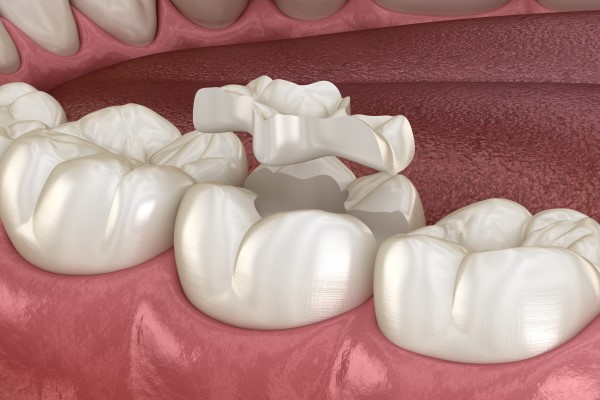How Is a Dental Inlay Used by Your Dentist?

A dentist may recommend a dental inlay to repair dental cavities or other forms of damage that affect the interior portion of the tooth (the grooves of teeth). Inlays are more commonly placed on molars and premolars rather than on teeth that are toward the front of the mouth and more visible.
The role of a dental inlay in dentistry
Many are less familiar with a dental inlay than a dental crown. There are a few similarities between the two, but there are also notable differences. The following review discusses what a dental inlay is, how it compares with alternative restorations, and when a dentist may recommend a dental inlay.
What is a dental inlay?
It is a type of dental restoration used to repair decay or damage in the grooves (chewing surfaces) of teeth. It is similar to a dental crown, but it only covers the inner part of the tooth, whereas a crown covers the entire tooth on all sides. A dental inlay is typically made of ceramic or metal material.
When might a dentist recommend a dental inlay?
Dental inlays are commonly used by dentists to treat dental cavities. It is often seen as an alternative to a dental filling and can be just as effective for treating minor to moderate-sized cavities caused by dental decay. A dental inlay can also treat other forms of teeth damage, such as chips or cracks to the grooves of teeth.
A dental inlay vs. alternative dental restorations
A dental inlay covers the grooves of teeth. It is different from a crown, which covers both the grooves and the cusps of teeth. A dental onlay covers the cusps of teeth but not the inner portion of the tooth. A dental inlay is different from a dental filling because an inlay is a single piece of material, whereas a filling using an amalgam is a material that is coated over the cavity. Dental inlays can also repair more than dental cavities, whereas a filling is almost exclusively used for cavities.
How to care for a dental inlay after placement
A dental inlay can last for more than a decade in many cases when the tooth is properly cared for by brushing regularly and using floss and mouthwash as recommended by the patient’s dentist. Regular check-up visits are also encouraged. Many patients who choose a dental inlay get used to it and do not notice that they have the restoration a few days after the inlay is placed by the dentist.
Get in touch with us today to schedule a dental visit
Our team is available by phone or message and is glad to answer your questions about dental restorations such as a dental inlay during a consultation visit. We treat a range of concerns and offer dental inlay treatment, and we take pride in helping our patients through the treatment process.
Request an appointment here: https://hemetdentalcenter.com or call Hemet Dental Center: Brian Stiewel DDS, INC. at (951) 707-4366 for an appointment in our Hemet office.
Check out what others are saying about our dental services on Yelp: Dental Inlay in Hemet, CA.
Recent Posts
Tooth extraction is a common dental procedure that general dentists perform on a regular basis. Although it is a routine and safe method, there are common misconceptions about it that cause unnecessary anxiety and fear. It is normal to feel a little nervous before any medical procedure, but it is equally important not to let…
Tooth extraction can relieve pain and discomfort, remove immediate threats to oral health, and open the door to more functional tooth replacements. While we strive to preserve your natural teeth for as long as possible, sometimes extractions are necessary. With the help of a general dentist, learn why there is no need to fear having…
When you hear you need a tooth extraction, it is common to worry about having a gap in your smile for the rest of your life. Fortunately, a general dentist can provide a tooth replacement to restore your smile. From dental implants to flipper teeth, there are many replacement options after a tooth extraction.Tooth extraction…
Many conditions can result in a tooth extraction, all of which boil down to the state of the tooth. There are two main types: simple and surgical. Take a closer look at each option and why we may recommend them.The goal of any general dentist is to preserve the natural teeth for as long as…


